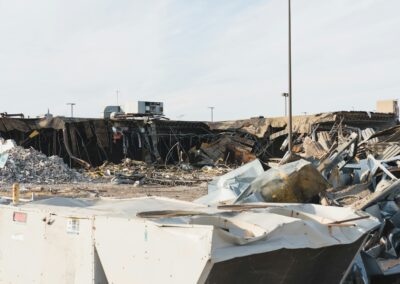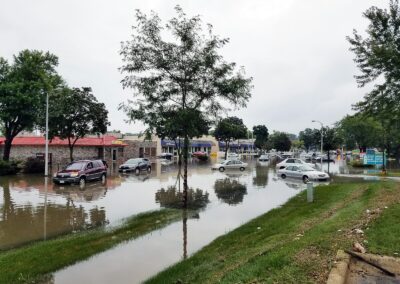Building a Comprehensive Strategy for Crisis Management
Understanding Disaster Recovery and Business Continuity
The integration of disaster recovery and business continuity plans is crucial for modern businesses aiming to ensure operational resilience. In today’s unpredictable environment, organizations in Saudi Arabia, UAE, Riyadh, and Dubai must be prepared for various crises that can disrupt their operations. Disaster recovery focuses on restoring IT systems and data after a disruption, while business continuity ensures that essential business functions continue during and after a crisis. By integrating these plans, businesses can create a robust framework for maintaining operations under any circumstances.
Disaster recovery involves detailed strategies for data backup, system restoration, and infrastructure rebuilding. This plan ensures that critical data and applications are quickly restored to minimize downtime and data loss. For example, a financial institution in Dubai might have a disaster recovery plan that includes off-site data backups and rapid deployment of standby systems to maintain banking services during a disruption.
Business continuity, on the other hand, encompasses a broader scope, ensuring that all essential business operations, including non-IT functions, can continue seamlessly. This includes strategies for maintaining customer service, supply chain management, and internal communications. In Riyadh, a retail company might implement a business continuity plan that includes alternative suppliers and remote work arrangements to keep operations running smoothly during a crisis.
The Importance of Integration
Integrating disaster recovery and business continuity plans provides a holistic approach to crisis management, ensuring that all aspects of the business are prepared for disruptions. This integration is particularly important for businesses in the rapidly growing markets of Saudi Arabia and the UAE, where resilience is key to sustaining growth and competitiveness. By aligning these plans, businesses can ensure that their IT recovery strategies support overall business continuity objectives, creating a seamless response to any crisis.
For instance, an integrated plan would ensure that data recovery efforts are synchronized with business processes, preventing gaps in service and communication. This synchronization is crucial for sectors such as healthcare in Riyadh, where timely access to patient records and uninterrupted service delivery are vital. An integrated approach ensures that IT systems are restored in alignment with clinical operations, maintaining high standards of care even during disruptions.
Moreover, the integration of these plans enhances coordination among different teams and departments within an organization. By having a unified strategy, businesses can streamline their crisis response efforts, reduce confusion, and improve the efficiency of their recovery actions. In Dubai, where businesses often operate across multiple locations and time zones, this coordination is essential for maintaining operational coherence and ensuring a swift recovery.
Leveraging Technology for Effective Integration
Advanced technologies such as artificial intelligence, blockchain, and the metaverse play a significant role in the effective integration of disaster recovery and business continuity plans. Artificial intelligence (AI) can analyze vast amounts of data to predict potential disruptions and recommend proactive measures. For example, AI can identify vulnerabilities in IT systems and suggest preemptive actions to mitigate risks, enhancing the resilience of businesses in Saudi Arabia and the UAE.
Blockchain technology can ensure the integrity and security of critical data, making it a valuable asset in disaster recovery efforts. By providing a decentralized and tamper-proof record of transactions, blockchain can protect data from corruption and unauthorized access during a crisis. This technology is particularly useful for financial institutions in Riyadh, where data security is paramount.
The metaverse, with its immersive and interactive capabilities, offers new opportunities for training and simulation. Businesses can use virtual environments to conduct disaster recovery drills and business continuity exercises, preparing their teams for real-life scenarios. In Dubai, where innovation is a driving force, leveraging the metaverse for crisis management training can enhance preparedness and improve response times.
Implementing Integrated Disaster Recovery and Business Continuity Plans
Developing a Unified Framework
To implement an integrated disaster recovery and business continuity plan, businesses must develop a unified framework that aligns their IT recovery strategies with overall business continuity objectives. This framework should outline the roles and responsibilities of different teams, establish clear communication channels, and define the processes for coordinating recovery efforts. In Saudi Arabia, where businesses operate in a fast-paced and competitive environment, having a well-defined framework is essential for ensuring a swift and effective response to disruptions.
The development process should involve a comprehensive risk assessment to identify potential threats and vulnerabilities. By understanding the specific risks faced by the organization, businesses can tailor their plans to address these challenges effectively. For example, a manufacturing company in Riyadh might identify supply chain disruptions as a critical risk and develop strategies to source materials from alternative suppliers during a crisis.
Furthermore, businesses should conduct regular reviews and updates of their integrated plans to ensure they remain relevant and effective. This continuous improvement process involves testing the plans through simulations and drills, gathering feedback from stakeholders, and making necessary adjustments. By maintaining an up-to-date and dynamic framework, businesses can enhance their resilience and preparedness for any crisis.
Ensuring Effective Communication
Effective communication is a cornerstone of integrated disaster recovery and business continuity plans. Clear and timely communication ensures that all stakeholders, including employees, customers, suppliers, and regulatory bodies, are informed and aligned during a crisis. Businesses must establish robust communication channels and protocols to facilitate the exchange of information and coordinate recovery efforts.
In Dubai, where businesses often have a diverse and dispersed workforce, leveraging modern communication tools is essential. Companies can use secure messaging platforms, video conferencing, and collaborative tools to keep their teams connected and informed. Additionally, businesses should develop communication templates and guidelines to ensure consistency and clarity in their messages during a crisis.
Moreover, communication plans should include strategies for engaging with external stakeholders, such as customers and suppliers. By providing regular updates and transparent information, businesses can maintain trust and confidence among their stakeholders. In the UAE, where customer loyalty is a key driver of business success, effective communication during a crisis can help businesses retain their customer base and mitigate the impact of disruptions.
Investing in Training and Awareness
Training and awareness programs are critical components of integrated disaster recovery and business continuity plans. Businesses must invest in training their employees on the procedures and protocols outlined in the plans, ensuring that everyone understands their roles and responsibilities during a crisis. Regular training sessions and workshops can enhance the preparedness and responsiveness of the workforce.
In Riyadh, businesses can conduct simulation exercises and drills to test their plans and identify areas for improvement. These exercises provide valuable insights into the effectiveness of the plans and help build a culture of resilience within the organization. By involving all employees in these activities, businesses can foster a sense of ownership and accountability, ensuring a coordinated and efficient response to any disruption.
Additionally, businesses should raise awareness about the importance of disaster recovery and business continuity among their stakeholders. By communicating the value of these plans and demonstrating their commitment to resilience, businesses can build trust and confidence. In Saudi Arabia and the UAE, where business relationships are built on trust and reliability, this awareness can enhance the reputation and credibility of the organization.
Conclusion
The integration of disaster recovery and business continuity plans is essential for ensuring operational resilience in today’s dynamic business environment. By developing a unified framework, leveraging advanced technologies, ensuring effective communication, and investing in training and awareness, businesses in Saudi Arabia, UAE, Riyadh, and Dubai can enhance their preparedness for any crisis. This comprehensive approach to crisis management enables businesses to maintain their operations, protect their assets, and achieve long-term success. As the business landscape continues to evolve, staying proactive and adaptive in crisis management will be key to sustaining growth and competitiveness.
—
#DisasterRecovery, #BusinessContinuity, #CrisisManagement, #OperationalResilience, #BusinessSuccess, #SaudiArabia, #UAE, #Riyadh, #Dubai, #ArtificialIntelligence, #Blockchain, #Metaverse, #GenerativeAI, #ModernTechnology, #Leadership, #ManagementSkills, #ProjectManagement























